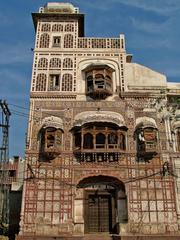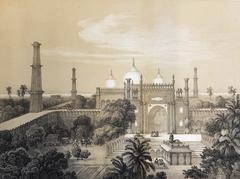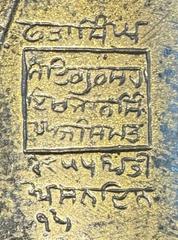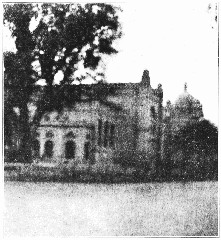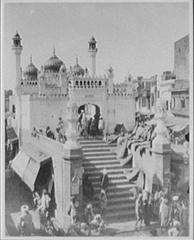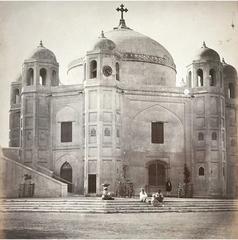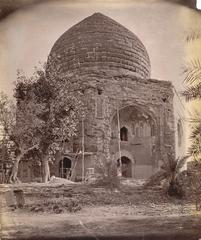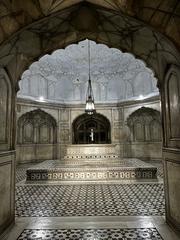Shalamar Gardens Lahore: Visiting Hours, Tickets, and Complete Travel Guide
Date: 14/06/2025
Introduction
Nestled in Lahore’s vibrant heart, Shalamar Gardens stands as an enduring symbol of Mughal landscape artistry and cultural heritage. Commissioned by Emperor Shah Jahan in 1641 and completed a year later, these majestic gardens embody the Mughal vision of a terrestrial paradise, uniting Persian-inspired design, terraced landscapes, and sophisticated hydraulic engineering. As a UNESCO World Heritage Site, Shalamar Gardens not only offers a tranquil retreat but also provides invaluable insight into the region’s layered history—spanning Mughal, Sikh, and British eras. This comprehensive guide details everything from visiting hours and ticket prices to historical significance, architectural marvels, conservation efforts, and essential travel tips, ensuring visitors make the most of this iconic Lahore landmark (Pride of Pakistan; Global Heritage Travel; UNESCO World Heritage Centre).
History and Custodianship
Commissioned by Mughal Emperor Shah Jahan, Shalamar Gardens was constructed between 1641 and 1642, embodying the zenith of Mughal architectural achievement (Pride of Pakistan). The Persian-style Charbagh layout, implemented by key figures like Khalilullah Khan and Ali Mardan Khan, brought to life a vision of paradise on earth. The Arain Mian Family of Baghbanpura, the original landowners, were entrusted with custodianship—a unique relationship lasting over three centuries and surviving through periods of Sikh and British rule (Wikipedia).
Nationalized in 1962, the gardens are now managed by the Government of Pakistan, with conservation supported by local and international organizations to maintain its UNESCO status (Scribd: UNESCO Report).
Mughal Garden Design and Persian Influence
The Shalamar Gardens exemplify the Mughal adaptation of the Persian Charbagh—an enclosed, four-part garden layout symbolizing the Quranic paradise. However, the Shalamar Gardens expand upon this with three descending terraces instead of four, each meticulously designed for distinct social and ceremonial purposes (Global Heritage Travel).
Covering approximately 39 acres (16 hectares), the gardens are enclosed by imposing red sandstone walls, providing both security and seclusion. The integration of axial water channels, geometric flowerbeds, and linear walkways reflects Persian influence, while the lush plantings and large pavilions are distinctive to Mughal innovation.
The Three Terraces: Symbolism and Function
The gardens are arranged on three north-facing terraces, each with unique symbolism:
- Farah Baksh (“Bestower of Pleasure”): The uppermost terrace, reserved for the royal family, boasts marble pavilions and panoramic views.
- Faiz Baksh (“Bestower of Goodness”): The central terrace hosted the emperor’s court, featuring audience halls and spaces for cultural gatherings.
- Hayat Baksh (“Bestower of Life”): The lowest terrace was accessible to the public and used for festivals and large assemblies (Global Heritage Travel).
The terraced design exploits a gentle slope to create dramatic cascades and enables gravity-fed water flow throughout the garden.
Hydraulic Engineering and Water Features
Water is the defining element of Shalamar Gardens. Fed originally by the Shah Nahar canal from the Ravi River, the gardens’ sophisticated hydraulic system channels water through 410 fountains, marble tanks, and ornamental cascades (World Heritage Site). The sound and coolness of water enhance the sensory experience and underscore the paradise motif. Maintenance of these features remains a challenge due to modern water shortages, highlighting the need for ongoing conservation.
Architectural and Artistic Highlights
Pavilions and Structures
- Baradaris: Open-sided, twelve-doored pavilions for ventilation and socializing.
- Diwan-e-Khaas: Hall of Private Audience, adorned with intricate marble and woodwork.
- Sawan Bhadun Pavilion: Famous for its water curtain, creating a cooling microclimate (Zameen).
- Naqar Khana (Drum House): Used for ceremonial music at the main entrance.
Decorative Features
- Marble and Sandstone Carvings: Geometric and floral motifs exemplifying Mughal craftsmanship.
- Inlay Work (Pietra Dura): Semi-precious stones set in marble.
- Frescoes and Tilework: Ornate ceilings and colorful mosaics.
- Acoustic Design: Enhanced sound for music and conversation (World Heritage Site).
Flora and Landscaping
The gardens feature a variety of indigenous and exotic trees—cypress, fruit, and flowering species—interspersed with seasonal blooms such as marigold, narcissus, jasmine, and lilies, providing year-round color and fragrance (UOP Journal). Symmetrical pathways and meticulously maintained lawns offer inviting spaces for relaxation.
Cultural Significance
Shalamar Gardens was historically a venue for royal festivities, poetry readings, and musical performances, encapsulating the Mughal ideal of the ruler as both cultural patron and public benefactor (Global Heritage Travel). Today, it remains a cherished public space for Lahore’s residents and visitors.
Conservation and UNESCO Status
Inscription and Value
The Shalamar Gardens, along with Lahore Fort, were inscribed as a UNESCO World Heritage Site in 1981 for their outstanding representation of Mughal garden and architectural traditions (UNESCO World Heritage Centre). The site’s universal value is found in its synthesis of Persian, Islamic, and South Asian traditions, its sophisticated waterworks, and its monumental pavilions.
Conservation Challenges
Major threats include urban encroachment, environmental degradation, and deterioration of water features and structures (UNESCO State of Conservation). The gardens were once listed as endangered, prompting restoration projects, stricter legal protections, and ongoing monitoring (UNESCO Danger List).
Recent Efforts
Pakistan’s Department of Archaeology and Museums, with UNESCO and international partners, has implemented restoration of marble tanks, fountains, and pavilions, and developed comprehensive management plans (Punjab Archaeology Department). The gardens were removed from the World Heritage in Danger list in 2012 due to significant progress in conservation (UNESCO Press Release).
Visiting Information
Location
- Address: Grand Trunk Road, northeast of Lahore’s Walled City, about 5 km from Lahore Fort (TravelPakistani).
- Transport: Accessible by taxi, rickshaw, ride-hailing services, and public transport.
Visiting Hours
- Open daily: 8:00 AM to 6:00 PM (may extend during summer; verify before visiting) (Zameen).
Ticket Prices
- Pakistani Adults: PKR 100
- Children under 12: PKR 50
- Foreign Tourists: PKR 300
- (Prices current as of 2025; confirm at entrance or Punjab Archaeology Department)
Accessibility
- Main pathways are paved and generally wheelchair accessible, but some terraces involve steps or uneven surfaces.
- Assistance is available at the entrance for differently-abled visitors.
Facilities and Tips
- Basic restrooms on site; no cafes—bring your own water and snacks.
- Wear comfortable walking shoes and sun protection.
- Photography is permitted; best light is early morning or late afternoon.
- Guided tours can be arranged through local operators or at the entrance (Khansays).
Nearby Attractions
Combine your Shalamar Gardens visit with other must-see Lahore sites:
- Lahore Fort (Shahi Qila)
- Badshahi Mosque
- Walled City of Lahore
- Hazuri Bagh
- Tomb of Jahangir
(All within short driving distance; TravelSetu)
Frequently Asked Questions (FAQ)
Q: What are Shalamar Gardens’ visiting hours?
A: Open daily from 8:00 AM to 6:00 PM.
Q: How much are tickets?
A: PKR 100 for locals, PKR 50 for children under 12, and PKR 300 for foreign tourists (2025 rates; check for updates).
Q: Are the gardens wheelchair accessible?
A: Main pathways are accessible, but some terraces may have steps.
Q: Can I take photographs?
A: Yes, photography is allowed and encouraged.
Q: Are guided tours available?
A: Yes, tours can be arranged at the entrance or via local agencies.
Practical Tips
- Check weather conditions before your visit.
- Respect conservation areas and avoid touching historic structures.
- Dispose of litter responsibly.
- Download the Audiala app for real-time updates and interactive maps.
Visual Gallery
Summary and Final Tips
Shalamar Gardens Lahore is a living testament to Mughal ingenuity, horticultural mastery, and the enduring appeal of Persian-inspired garden design. Despite the pressures of urbanization, environmental change, and heavy visitation, dedicated conservation efforts have preserved its splendor for future generations. Visitors are encouraged to explore its terraces, marvel at the flowing waterworks, and appreciate the artistic details that make Shalamar Gardens a jewel among Lahore’s historical sites. For the most enriching experience, plan ahead, respect conservation guidelines, and consider a guided tour.
References and Further Reading
- Pride of Pakistan - Shalamar Gardens
- Global Heritage Travel - Visit Shalamar Gardens UNESCO World Heritage
- UNESCO World Heritage Centre - Fort and Shalamar Gardens in Lahore
- Punjab Archaeology Department
- Wikipedia - Shalimar Gardens, Lahore
- New World Encyclopedia - Fort and Shalamar Gardens in Lahore
- Scribd: UNESCO Report on Shalamar Garden Lahore
- World Heritage Site
- Zameen - Shalamar Gardens Blog
- UOP Journal Article
- Graana - Shalamar Gardens
- House of Pakistan Blog
- TravelPakistani
- Khansays
- TravelSetu
